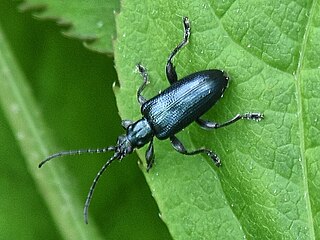
The kola nut is the seed of certain species of plant of the genus Cola, placed formerly in the cocoa family Sterculiaceae and now usually subsumed in the mallow family Malvaceae. These cola species are trees native to the tropical rainforests of Africa. Their caffeine-containing seeds are used as flavoring ingredients in various carbonated soft drinks, from which the name cola originates.

Hevea is a genus of flowering plants in the spurge family, Euphorbiaceae, with about ten members. It is also one of many names used commercially for the wood of the most economically important rubber tree, H. brasiliensis. The genus is native to tropical South America but is widely cultivated in other tropical countries and naturalized in several of them. It was first described in 1775.
Uropeltis nitida is a species of nonvenomous shieldtail snake. The species is endemic to southern India. There are no subspecies that are recognized as being valid.
Neomacounia nitida, or Macoun's shining moss, is an extinct moss that was found only in a small area of Ontario, and the sole species in the genus Neomacounia.

Chiococca is a genus of flowering plants in the family Rubiaceae. It currently holds 23 species that are native to Florida, Texas, Mexico, Central America, much of South America, the West Indies, and the islands of Galápagos and Fernando de Noronha.

Lonicera nitida is a species of flowering plant in the honeysuckle family. In English, it is sometimes given the common names box honeysuckle or Wilson's honeysuckle. It is widely used as a low hedging plant, and for topiary. It is also a popular low-maintenance ground cover plant for urban landscaping.

Gasteria armstrongii is a dwarf succulent plant native to South Africa, in the genus Gasteria.

Coprosma nitida, the mountain currant or shining currant, is a shrub species endemic to south-east Australia. It is a shrub with small, glossy leaves, occasional spines on the end of its branchlets, and small bright red-orange fruits.

The Barrier Reef chromis, also known as the yellowback puller or shining puller, is a species of damselfish in the family Pomacentridae native to the east coast of Australia. It is a small fish with a yellowish-brown dorsal surface separated by a dark stripe from its silvery flanks and underside.

Hakea nitida, commonly called the frog hakea or shining hakea, is a shrub of the family Proteaceae and is endemic to an area in the southern Wheatbelt, Great Southern and Goldfields-Esperance regions of Western Australia.

Plateumaris is a genus of aquatic leaf beetles in the family Chrysomelidae. There are about 17 described species in Plateumaris.

Rhyssella is a genus of ichneumon wasps in the family Ichneumonidae. There are about 10 described species in Rhyssella.

Rhyssella nitida is a species of ichneumon wasp in the family Ichneumonidae.
Eudioctria brevis is a species of robber flies in the family Asilidae.
Phyllophaga nitida is a species of scarab beetle in the family Scarabaeidae. It is found in North America.

Colaspidea is a genus of leaf beetles in the subfamily Eumolpinae. It is known from North America and the Mediterranean. It has recently been suggested that the Mediterranean species of Colaspidea are a sister genus to Chalcosicya, and that Colaspina forms a sister genus to the former two combined. It has also been suggested that the North American species of Colaspidea may represent a separate genus.
Eudioctria sackeni is a species of robber flies in the family Asilidae.

Plateumaris nitida is a species of aquatic leaf beetle in the family Chrysomelidae. It is found in North America.
Eudioctria tibialis is a species of robber flies in the family Asilidae.












